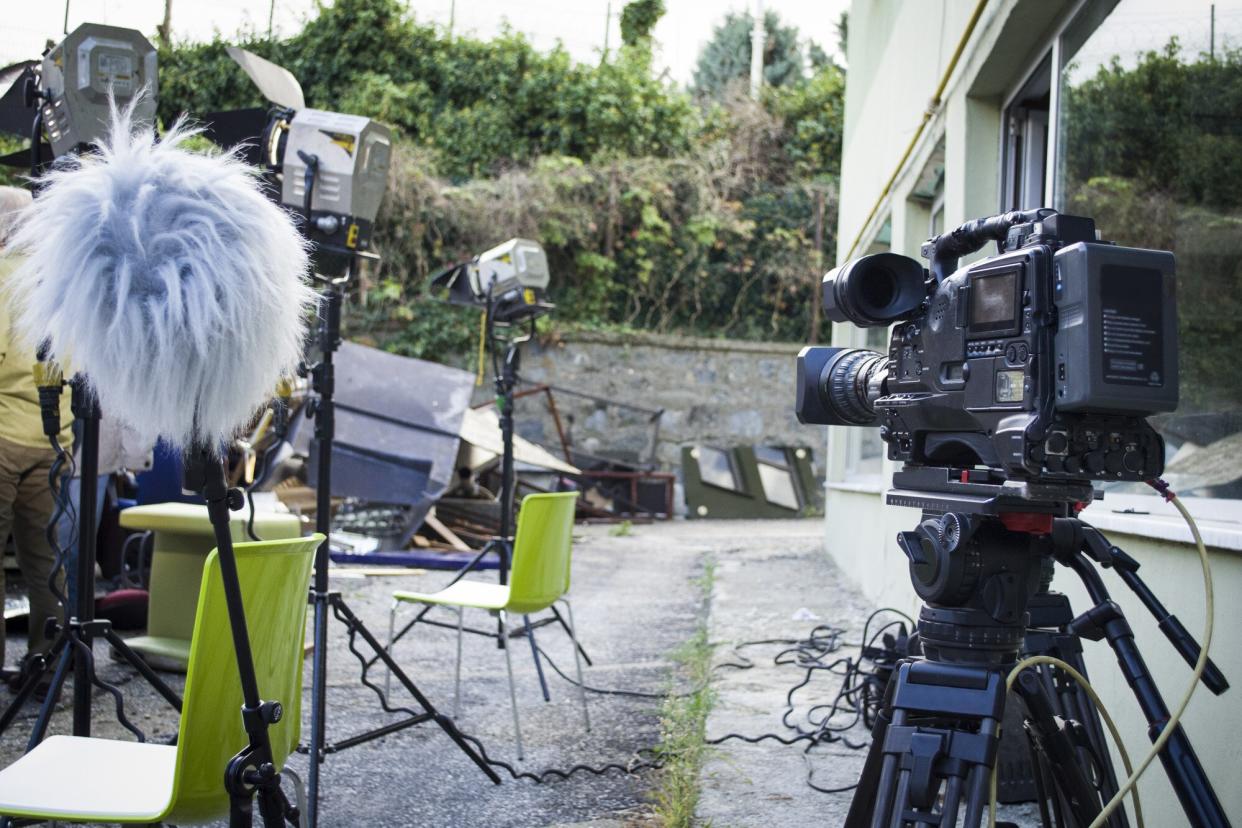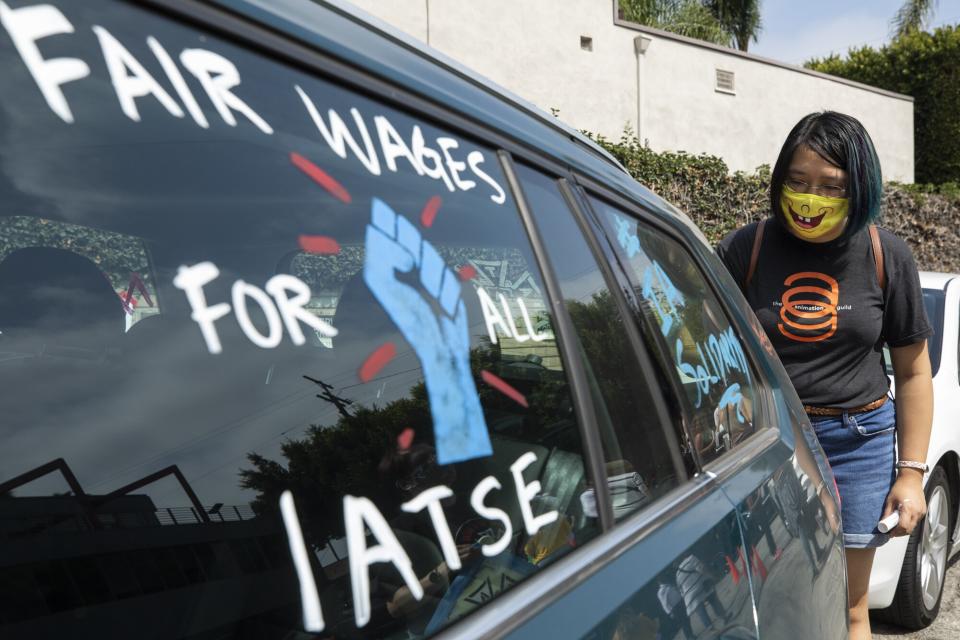Hollywood crews are poised to strike over brutal working conditions: Here's what you should know

Getty Images Lights, camera… strike?
Throughout the summer of 2021, long-simmering tensions in the entertainment industry were coming to a boil. Crew members across the industry, from cinematographers to costume designers to grips, were increasingly raising their voices to protest the long hours, low wages, and lack of basic benefits that have long been taken for granted in Hollywood.
Now one of the industry's largest labor unions, the International Alliance of Theatrical Stage Employees, is poised to authorize a strike within the next week, as tensions continue to grow between the studios that bankroll and release Hollywood's output and the workers that actually make that output. While a strike is hardly a certainty, even if the union votes to authorize one, the industry seems to have finally reached a tipping point, and many frustrated and exhausted crew members are prepared to keep fighting for change.
"It certainly has not felt like the employers see us as humans, and recognize or acknowledge the real human toll that the current working conditions in the industry take," Marisa Shipley, an art department coordinator and vice president of IATSE Local 871, tells EW. "I do hope that so many crew members speaking out makes a difference, and they hear us."
IATSE's strike authorization vote is set to begin Friday, with the results expected to be announced Monday. In the meantime, here's what you need to know about the dispute, the players involved, and what it could mean for the future of entertainment.
What is IATSE, and who's in it?
IATSE represents more than 150,000 crew members across various "below-the-line" positions in the entertainment industry, including editors, art directors, electricians, hairstylists, and more. (The union also includes workers in live theater, concerts, and trade shows as well as film and TV production.) IATSE is essentially an umbrella organization for various unions and guilds within the industry, known as locals; Local 700, for instance, is the nationwide Motion Picture Editors Guild, which represents thousands of film editors and other post-production workers. In short, IATSE is made up of the craftspeople and technicians who help make your favorite movies and shows; almost all major Hollywood productions are made under IATSE's jurisdiction and crewed by union workers. (You've seen the IATSE logo if you've ever watched a movie or TV show's credits to the end.)
Why would IATSE go on strike?
IATSE's members are currently fighting to improve working conditions that have persisted in the entertainment industry for decades, particularly the grueling hours required on film and TV shoots. A "normal" workday for such a shoot is typically 12 hours, but crew members say they can often stretch much longer, sometimes requiring them to work as much as 20 hours straight without a substantial break.
"In the era that I came up in, that was the mindset: You worked whatever it took to get the job done," says Steve Dayan, secretary-treasurer of Teamsters Local 399 and a 45-year veteran of the film industry, who adds that he once worked a 36-hour day earlier in his career. "Going from a day schedule to a night schedule, and then going back to a day schedule, and you're outside and in the elements a lot of the time — all of those things take a toll."
And the cost has been evident for years. A previous flashpoint for the industry came in 1997, when camera operator Brent Hershman fell asleep at the wheel and was killed while driving home from a 19-hour workday on the set of Pleasantville. (This was far from an isolated incident; Dayan says much the same thing happened to a crew member on a movie he worked on.) Hershman's death prompted conversations and a wrongful death lawsuit but little actual change. Nearly a decade later, cinematographer Haskell Wexler publicly took IATSE leadership to task in a 2006 documentary on the industry's working conditions, Who Needs Sleep?

Myung J. Chun / Los Angeles Times via Getty Images Window art in support of IATSE in Los Angeles
But a confluence of factors finally brought these conversations to a head this year. The months-long production shutdown caused by the COVID-19 pandemic prompted many workers to take stock of their lives and careers for the first time, and to come to terms with the toll that their work in the industry had taken.
"You realize, I've finally gotten over a week's worth of quality rest, and I don't feel so depressed. It's like we all sobered up for a few months," says Hassan Abdul-Wahid, a camera operator and member of the International Cinematographers Guild (IATSE Local 600). "For me, it was like, I can be a dad again. I can be a supportive husband. I didn't know how strung out I was from 20-odd years of doing this until I didn't have to do it for a few months."
Crew members have also started to become more vocal on social media. The Instagram page IATSE Stories has been collecting publicly anonymous accounts of working conditions on set, with crew members sharing stories of exhaustion, burnout, and in some cases, near-death experiences. The page has more than 1,000 posts since launching in August.
"Just got home after four weeks of 10-hour days with 'rolling lunches' and broke down crying in my kitchen," wrote one director of photography, who said he has spent 23 years in the industry. ("Rolling lunches" refers to working through a scheduled meal break on set.) "This has been my life for two and a half decades — missed moments and a half-lived life with friends and family. Depression. Substance abuse. Denial of self-care. Denial of self-worth."
Meanwhile, IATSE leadership has been negotiating a new contract with the Alliance of Motion Picture and Television Producers, which represents Hollywood's major production companies and studios (including streaming services). In the contract talks, IATSE pushed for mandated meal breaks and rest periods, standardized turnaround times between workdays, and higher wages for crew members, particularly on streaming (or "new media") projects. Negotiations broke down, however, when the AMPTP declined to respond to the union's most recent proposal earlier this month. This prompted IATSE president Matthew Loeb to call for a strike authorization vote "to demonstrate our commitment to achieving the change that is long overdue in this industry," per a union statement.
The AMPTP did not respond to EW's request for comment but told Deadline in a statement, "The AMPTP put forth a deal-closing comprehensive proposal that meaningfully addresses the IATSE's key bargaining issues… In choosing to leave the bargaining table to seek a strike authorization vote, the IATSE leadership walked away from a generous comprehensive package."
What happens next?
The 13 West Coast locals covered under IATSE's deal with the AMPTP will begin voting on whether to authorize a strike on Friday. This does not mean they're voting to go on strike immediately, however. If the vote passes — and it's expected to pass overwhelmingly — IATSE leadership will simply have the authority to call for a strike if they so choose. As noted above, though, it's far from guaranteed that they will do so.
"Our goal is not to strike. Our goal is a fair deal," IATSE president Loeb tweeted Thursday. Amy Hartman, a script coordinator and Local 871 member, echoes Loeb: "We don't want a strike. But we do need a deal that works for us. And so far, the AMPTP has been completely unwilling to move in our direction."
But not every crew member feels the same way. "Personally, I want to see a strike, and I think it will happen," Abdul-Wahid says. "I think that's the only way producers and studios are going to take this seriously, and I don't think anybody in charge has any concept of what the crew actually experiences on a day-to-day basis."
What will happen if IATSE does strike?
If IATSE does indeed strike, production on the vast majority of TV shows and movies will have to shut down. Some productions would continue; certain cable networks, including HBO, Showtime, BET, and Starz, are covered under separate IATSE contracts, which remain in place. But all workers covered by the agreements under negotiation — more than 60,000 in total — could walk off the job if a strike is called, leaving essentially every position required to make a movie or series unfilled.
How long would a strike last?
In short, it's unclear. It seems doubtful that studios would be willing to allow a long-term production shutdown, which would be even more damaging to movies and TV than the 2008 writers' strike. A strike would also be difficult for crew members who would have to go months without work, but those who spoke to EW say the changes they're fighting for would be worth the cost.
"What I hear from members is that they are committed to needing substantive change on these issues," Local 871's Shipley says. "And our union has our back. I think that we will find the ways to support our community and carry one another through it if there ultimately is a strike."
"We're not machines," adds Abdul-Wahid. "You don't get to wear us out and replace us. These are actual people who care about what they're trying to do, who want to be in Hollywood making movies and TV shows. To use that against us is ridiculous."
Related content:

